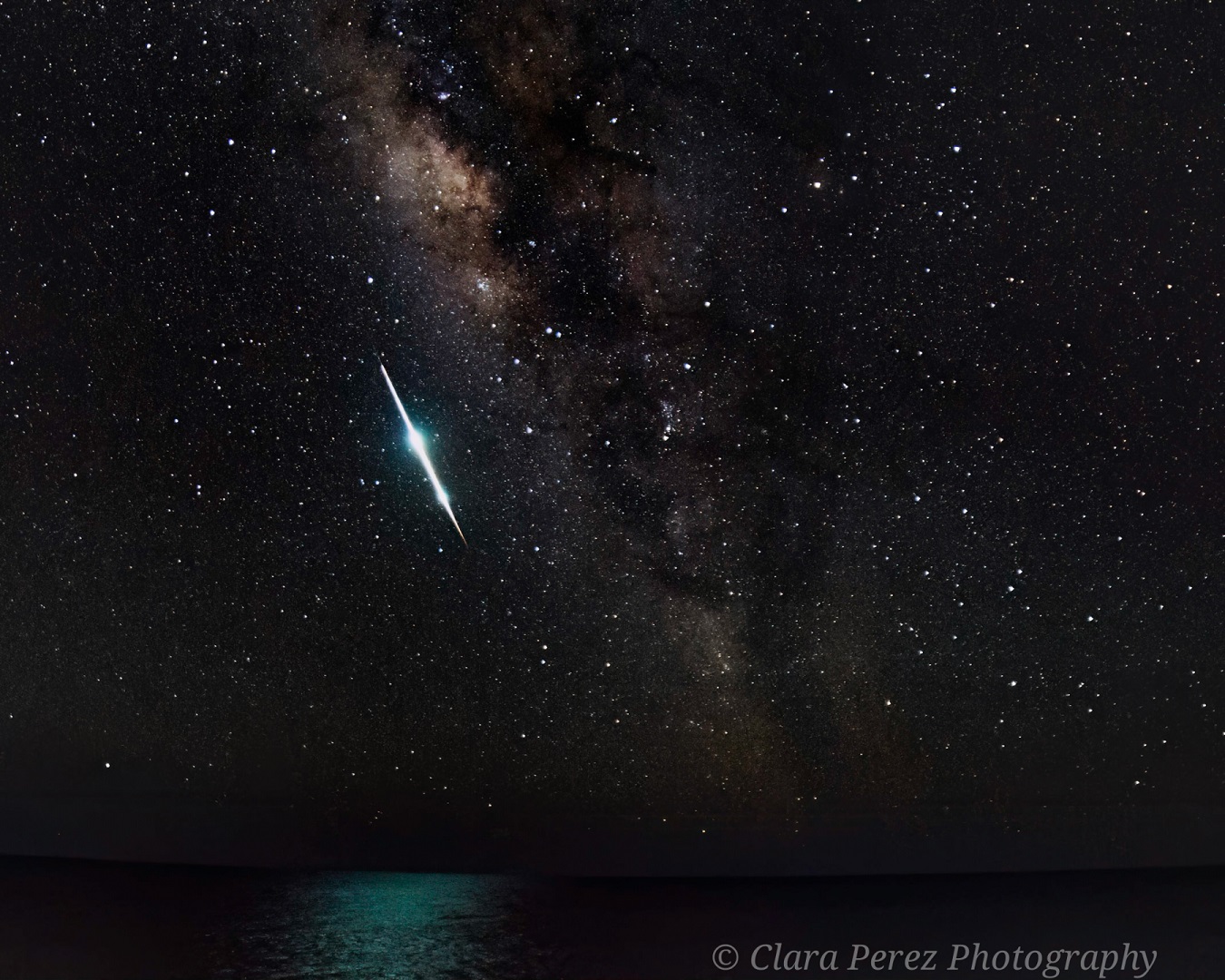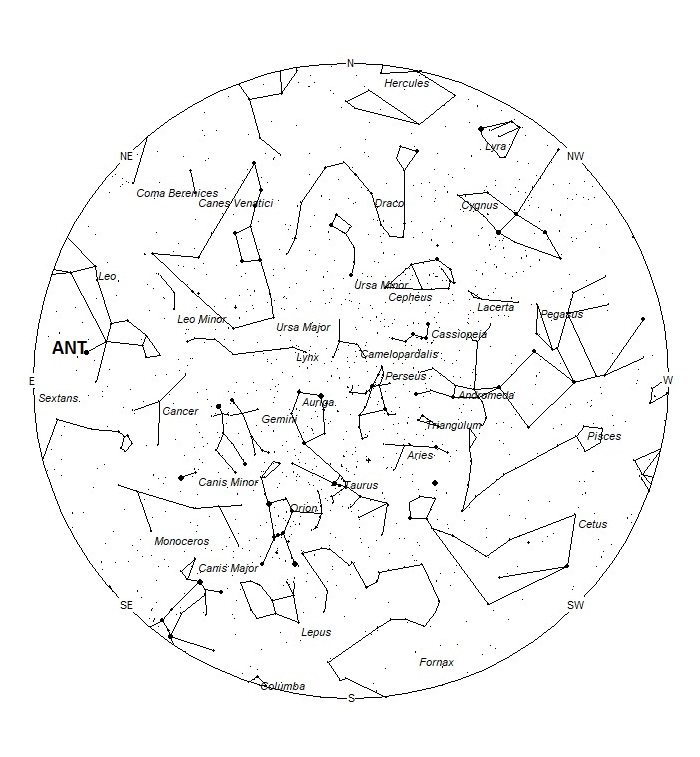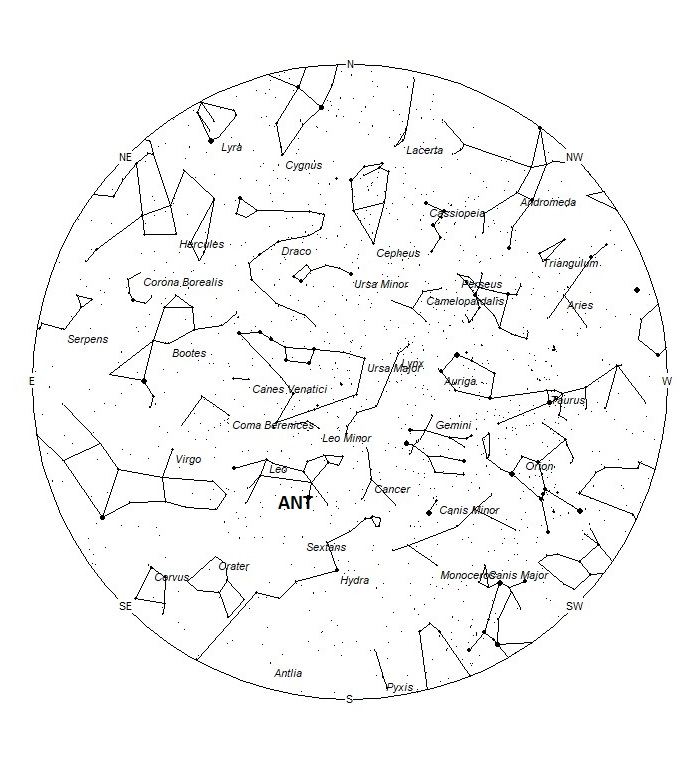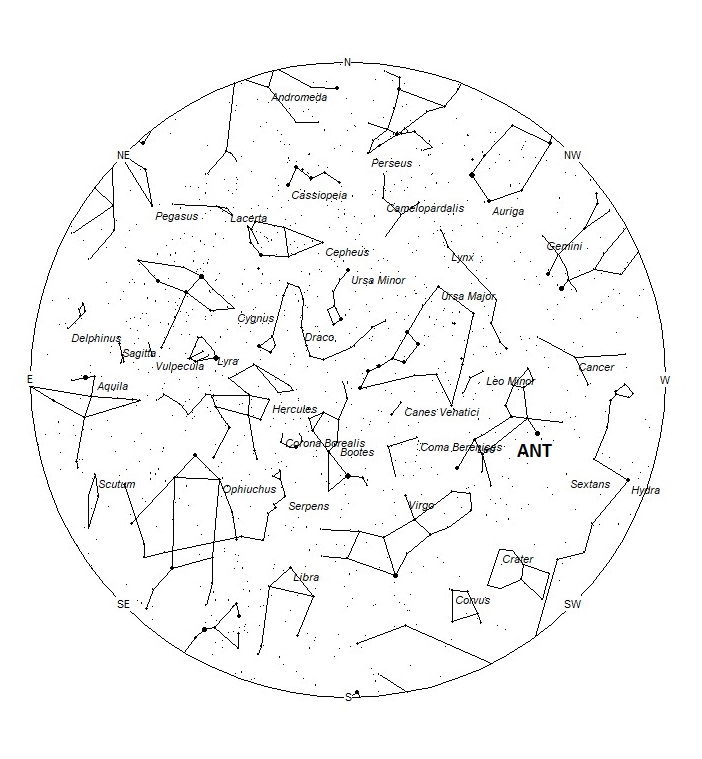
During this period, the moon waxes from just past new to half-illuminated by Friday February 16th. This weekend the waxing crescent moon will set shortly after dusk, leaving the remainder of the night free of interfering moonlight. With each passing night the moon’s phase increases plus it sets approximately 45 minutes later each night. By Friday the first quarter moon will set near midnight making evening meteor observing a bit more of a challenge with the bright moon above the horizon. The estimated total hourly rates for evening observers this weekend should be near 3 as seen from mid-northern latitudes (45N) and 4 as seen from tropical southern locations (25S) For morning observers, the estimated total hourly rates should be near 10 as seen from mid-northern latitudes (45N) and 18 as seen from tropical southern locations (25S). The actual rates seen will also depend on factors such as personal light and motion perception, local weather conditions, alertness, and experience in watching meteor activity. Note that the hourly rates listed below are estimates as viewed from dark sky sites away from urban light sources. Observers viewing from urban areas will see less activity as only the brighter meteors will be visible from such locations.
The radiant (the area of the sky where meteors appear to shoot from) positions and rates listed below are exact for Saturday night/Sunday morning February 10/11. These positions do not change greatly day to day so the listed coordinates may be used during this entire period. Most star atlases (available at science stores and planetariums) will provide maps with grid lines of the celestial coordinates so that you may find out exactly where these positions are located in the sky. I have also included charts of the sky that display the radiant positions for evening, midnight, and morning. The center of each chart is the sky directly overhead at the appropriate hour. These charts are oriented for facing south but can be used for any direction by rotating the charts to the desired direction. A planisphere or computer planetarium program is also useful in showing the sky at any time of night on any date of the year. Activity from each radiant is best seen when it is positioned highest in the sky, either due north or south along the meridian, depending on your latitude. Radiants that rise after midnight will not reach their highest point in the sky until daylight. For these radiants, it is best to view them during the last few hours before dawn. It must be remembered that meteor activity is rarely seen at its radiant position. Rather they shoot outwards from the radiant, so it is best to center your field of view so that the radiant lies toward the edge and not the center. Viewing there will allow you to easily trace the path of each meteor back to the radiant (if it is a shower member) or in another direction if it is sporadic. Meteor activity is not seen from radiants that are located far below the horizon. The positions below are listed in a west to east manner in order of right ascension (celestial longitude). The positions listed first are located further west therefore are accessible earlier in the night while those listed further down the list rise later in the night.
These sources of meteoric activity are expected to be active this week
.
The large Anthelion (ANT) is currently centered at 10:20 (155) +10. This position lies in southwestern Leo, 3 degrees southeast of the 1st magnitude star known as Regulus (alpha Leonis). Due to the large size of this radiant, these meteors may also be seen from northern Sextans and northwestern Hydra as well as Leo. This radiant is best placed near 01:00 local standard time (LST) when it lies on the meridian and is highest in the sky. Rates at this time should be near 3 per hour as seen from the northern hemisphere and 2 per hour as seen from south of the equator. With an entry velocity of 30 km/sec., the average Anthelion meteor would be of slow velocity.
The gamma Crucids (GCR) were discovered in 2021 by the CAMS system of meteor cameras managed by Dr. Peter Jenniskens. This shower is active from February 11-15 with a peak on the 14th. At maximum, the radiant is located at 12:32 (193) -56. This area of the sky is located in northern Crux, only 1 degree north of the 2nd magnitude star known as Gacrux (gamma Crucis). Observers in the southern hemisphere are greatly favored in seeing these meteors as the radiant does not clear the horizon for the northern two-thirds of the northern hemisphere. 40 of these meteors were captured in 2021. These meteors are best seen near 03:00 LST when the radiant lies highest above the southern horizon. With an entry velocity of 56 km/sec., the average meteor from this source would be swift.
The alpha Centaurids (ACE) are active from February 3-20, with maximum activity occurring on February 9th. The radiant is currently located at 14:14 (213) -59. This position lies in southeastern Centaurus, 2 degrees northeast of the 1st magnitude star known as Hadar (beta Centauri). Due to the southern declination of this radiant, these meteors are not well seen in the northern hemisphere. Current hourly rates are expected to be less than 1 as seen from the northern hemisphere and 3 as seen from south of the equator. These meteors are best seen near 05:00 LST when the radiant lies highest above the horizon. At 56 km/sec. the alpha Centaurids would produce mostly swift meteors.
Sporadic meteors are those meteors that cannot be associated with any known meteor shower. All meteor showers are evolving and disperse over time to the point where they are no longer recognizable. Away from the peaks of the major annual showers, these sporadic meteors make up the bulk of the activity seen each night. As seen from the mid-northern hemisphere (45N) one would expect to see during this period approximately 7 sporadic meteors per hour during the last hour before dawn as seen from rural observing sites. Evening rates would be near 2 per hour. As seen from the tropical southern latitudes (25S), morning rates would be near 12 per hour as seen from rural observing sites and 3 per hour during the evening hours. Locations between these two extremes would see activity between these listed figures.
You can keep track of the activity of these meteor showers as well as those beyond the limits of visual observing by visiting the NASA Meteor Shower Portal. You can move the sky globe to see different areas of the sky. Colored dots indicate shower meteors while white dots indicate sporadic (random) activity. The large orange disk indicates the position of the sun so little activity will be seen in that area of the sky.
The list below offers the information in tabular form of the showers that I feel are within reach of the visual observer to discern. Hourly rates are often less than one, so these sources are rarely listed as visual targets in most meteor shower lists. If you are like me though and wish to associate as many meteors as possible with known sources, then you will appreciate these listings. Before listing meteors from these obscure sources, you should attempt to prove these meteors belong to them and are not chance alignments of sporadic meteors. You can note parameters such as duration, length, radiant distance and the elevation of each meteor to help compute the probability of shower association. It should be remembered that slow meteors can be seen from fast showers, but fast meteors cannot be produced from slow showers. Slower showers are those with velocities less than 35/km per second. Slow meteors can appear from fast showers when they appear close to the radiant or low in the sky. The table located on IMO’s 2024 Meteor Shower Calendar is a big help in aiding in the identification of meteors. If you record the length and duration of each meteor, you can use this chart to check the probability of the meteor belonging to a shower of known velocity. If the angular velocity is similar to the figure in the table, then your meteor probably belongs to that shower. Rates and positions are exact for Saturday night/Sunday morning.
| SHOWER | DATE OF MAXIMUM ACTIVITY | CELESTIAL POSITION | ENTRY VELOCITY | CULMINATION | HOURLY RATE | CLASS |
| RA (RA in Deg.) DEC | Km/Sec | Local Standard Time | North-South | |||
| Anthelions (ANT) | – | 10:20 (155) +10 | 30 | 01:00 | 3 – 2 | II |
| gamma Crucids (GCR) | Feb 14 | 12:32 (193) -56 | 56 | 03:00 | ? | III |
| alpha Centaurids (ACE) | Feb 09 | 14:14 (213) -59 | 56 | 05:00 | <1 – 3 | II |
Class Explanation: A scale to group meteor showers by their intensity:
- Class I: the strongest annual showers with Zenith Hourly Rates normally ten or better.
- Class II: reliable minor showers with ZHR’s normally two to ten.
- Class III: showers that do not provide annual activity. These showers are rarely active yet have the potential to produce a major display on occasion.
- Class IV: weak minor showers with ZHR’s rarely exceeding two. The study of these showers is best left to experienced observers who use plotting and angular velocity estimates to determine shower association. These weak showers are also good targets for video and photographic work. Observers with less experience are urged to limit their shower associations to showers with a rating of I to III.
 American Meteor Society
American Meteor Society



I think I saw a metor coming down in concord va at 12:30 am tonight but it was a bright white ball with an orange fiery tail and it got real bright and disappeared a few seconds later